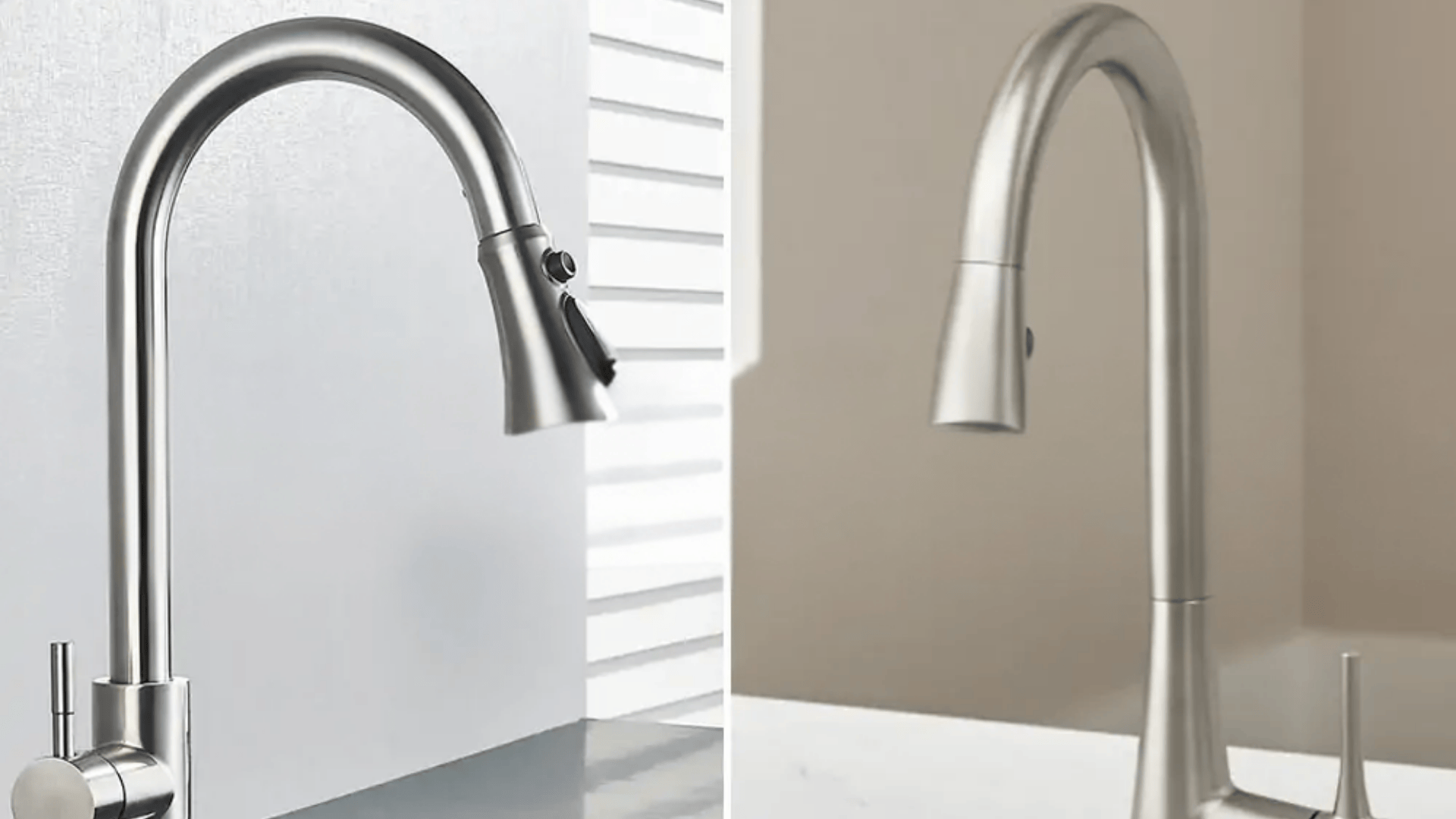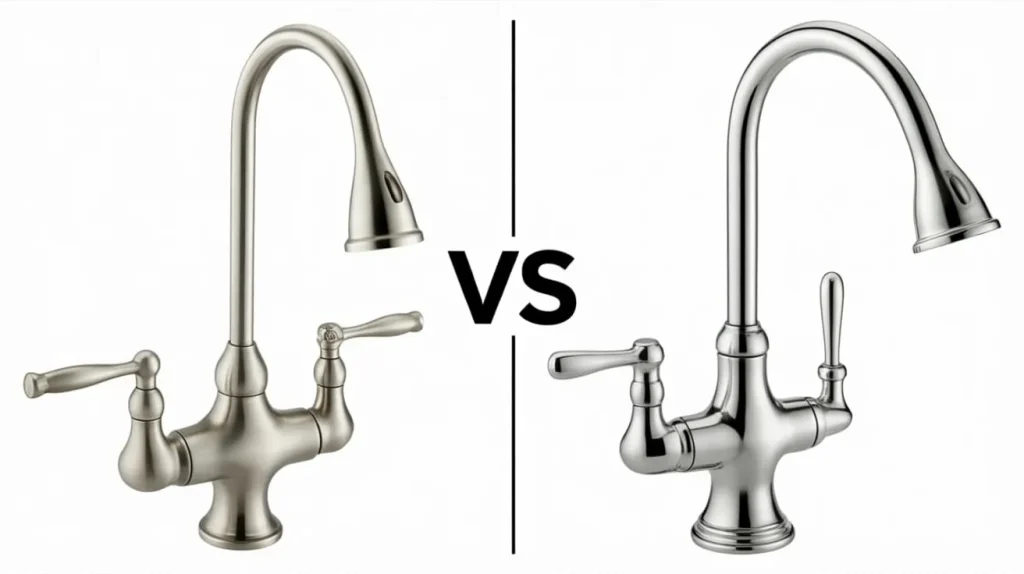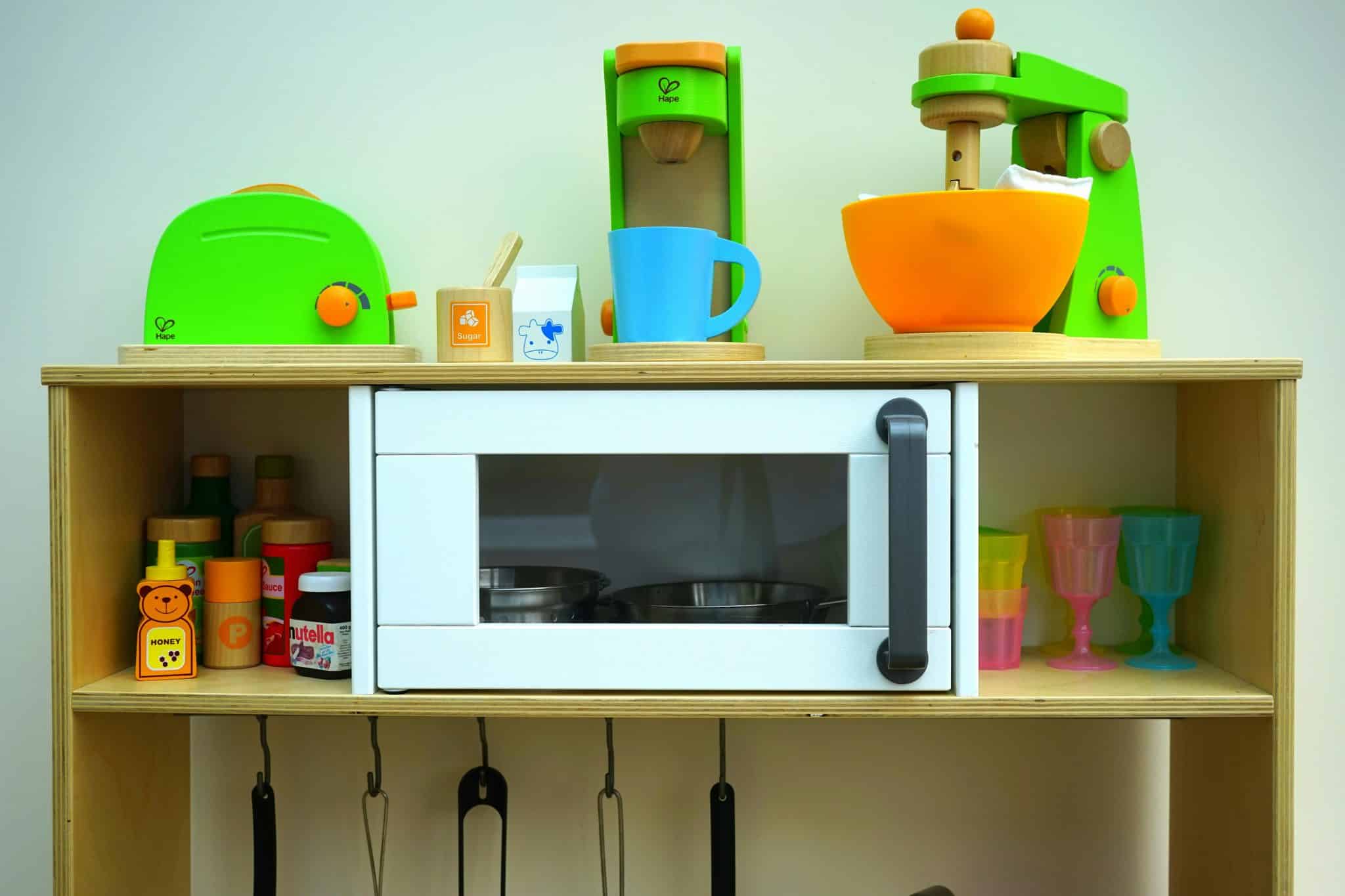Standing in the home improvement store, you’re staring at two beautiful faucets. One has the warm, muted glow of brushed nickel.
The other gleams with stainless steel’s cool, modern shine. Both look great, but which one belongs in your home?
This choice affects more than just one fixture. Your decision impacts kitchen appliances, bathroom hardware, cabinet pulls, and lighting throughout your space.
The wrong finish can make your home feel disjointed and dated. The right choice creates a cohesive, polished look that increases your property value.
This guide breaks down everything you need to know about brushed nickel vs stainless steel. You’ll learn which finish works best for kitchens, bathrooms, and open-plan homes.
Let’s solve this design dilemma once and for all.
What is Brushed Nickel?
Brushed nickel is a metal finish created by coating base metals like brass or zinc with a layer of nickel, then brushing the surface with fine abrasives to create subtle linear textures.
This process gives brushed nickel its signature warm, muted appearance with a soft matte finish that doesn’t shine like polished metals.
You’ll commonly find brushed nickel on bathroom faucets, cabinet pulls, door handles, and light fixtures throughout modern homes.
The finish works well with both contemporary and traditional design styles because its neutral tone complements warm paint colors, natural wood cabinets, and stone countertops without competing for attention.
| Pros | Cons |
|---|---|
| Warm, soft, and muted look that hides fingerprints & water spots | Can appear dull in low lighting |
| Low maintenance and easy to keep clean | Less sleek than stainless steel for ultra-modern designs |
| Highly resistant to tarnish and corrosion | Limited match with shiny appliances |
| Works well in traditional, farmhouse, and transitional styles | Premium options can be pricey |
What is Stainless Steel?
Stainless steel is a durable metal alloy made from steel mixed with at least 10.5% chromium, which creates a protective layer that resists rust and corrosion.
This material comes in two main finish types: polished stainless steel with a mirror-like shine, and brushed stainless steel with fine linear scratches that create a matte appearance.
Stainless steel dominates kitchen design because it matches major appliances like refrigerators, dishwashers, and ranges, while also working perfectly for sinks and faucets that need to handle daily water exposure.
The calm, silvery tone fits seamlessly into modern minimalist kitchens, industrial loft spaces, and contemporary designs where clean lines and neutral colors take center stage.
| Pros | Cons |
|---|---|
| Sleek, cool, and modern appearance | Shows fingerprints and water spots easily |
| Extremely durable, rust- and corrosion-resistant | Can feel cold or harsh in warm-toned spaces |
| Matches most appliances for a cohesive look | Higher-grade options can be expensive |
| Easy to clean with common household products | Prone to visible scratches over time |
Key Differences: Brushed Nickel vs Stainless Steel
Brushed nickel and stainless steel may seem similar, but they differ in tone, finish, maintenance, and how they complement your space.
1. Appearance & Color Tone
Brushed nickel brings warm, golden undertones that create a soft, cozy feeling in any room.
The muted finish has a subtle champagne-like glow that pairs beautifully with warm paint colors and wood tones.
Stainless steel offers a cool, crisp, silvery appearance with blue-gray undertones that feels fresh and modern.
This cooler tone works best with white, gray, and black color schemes where you want a clean, professional look.
2. Durability & Corrosion Resistance
Stainless steel wins the durability battle with superior resistance to rust, corrosion, and daily wear in wet environments like kitchens and bathrooms.
The chromium content creates a protective barrier that handles moisture, heat, and humidity without breaking down.
Brushed nickel performs well in dry areas but can show wear over time in high-moisture spaces.
Both finishes resist tarnishing better than cheaper alternatives, but stainless steel maintains its appearance longer in challenging conditions.
3. Maintenance & Cleaning
Brushed nickel hides fingerprints and water spots better thanks to its textured, matte surface that camouflages smudges and daily use marks.
Simple soap and water keep it looking fresh with minimal effort. Stainless steel shows every fingerprint, water spot, and streak, requiring frequent cleaning with specialized stainless steel cleaners.
The polished versions need even more attention, while brushed stainless steel forgives minor marks better than its shiny counterpart.
4. Cost & Budget Impact
Brushed nickel typically costs 15-25% more than basic stainless steel options, with kitchen faucets ranging from $150-$400 compared to $120-$300 for stainless steel equivalents.
Cabinet hardware in brushed nickel runs $8-$15 per pull versus $5-$12 for stainless steel versions.
However, both finishes fall into the mid-range price category, making the cost difference less significant than the style preference for most homeowners.
5. Finish Longevity
Stainless steel maintains its original appearance for 10-15 years with proper care, showing minimal fading or wear in most home environments.
Brushed nickel holds up well for 7-10 years but may develop slight discoloration or wear patterns in high-traffic areas like kitchen sinks and bathroom vanities.
Both finishes outlast painted or coated alternatives, but stainless steel edges ahead for long-term durability and consistent appearance over time.
Which Works Best for Your Space?
The right finish depends on where it’s used; kitchens, bathrooms, and open-plan spaces each have different styles and durability needs.
1. For Kitchens
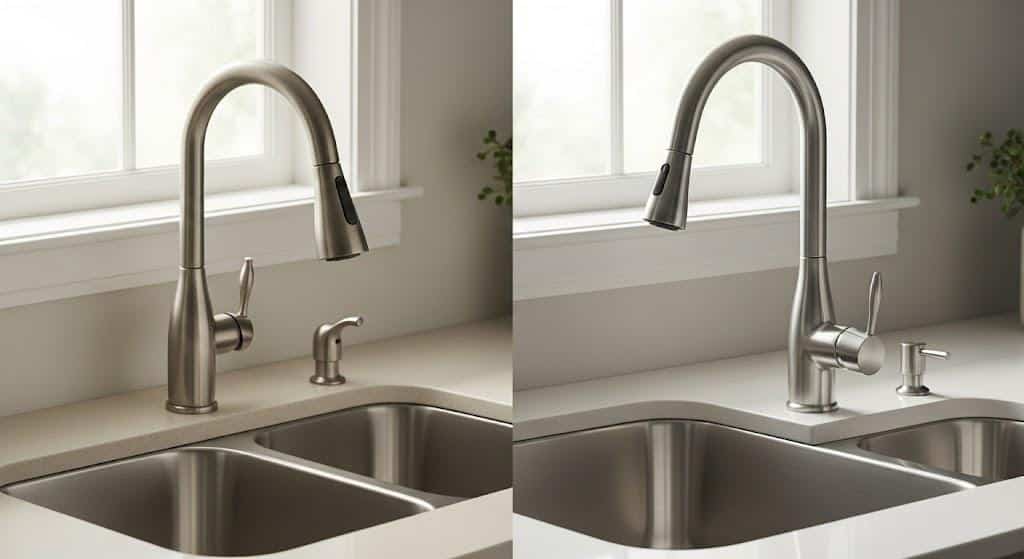
Brushed nickel works better in kitchens with colored or panel-ready appliances where you want warmth and character. This finish pairs beautifully with white cabinets, warm wood tones, and natural stone countertops for a more traditional or transitional style.
Stainless steel takes the lead in kitchens because it matches your major appliances like refrigerators, dishwashers, and ranges perfectly. Choose stainless steel cabinet pulls, sink faucets, and range hoods to create a cohesive look that feels intentional and polished.
2. For Bathrooms
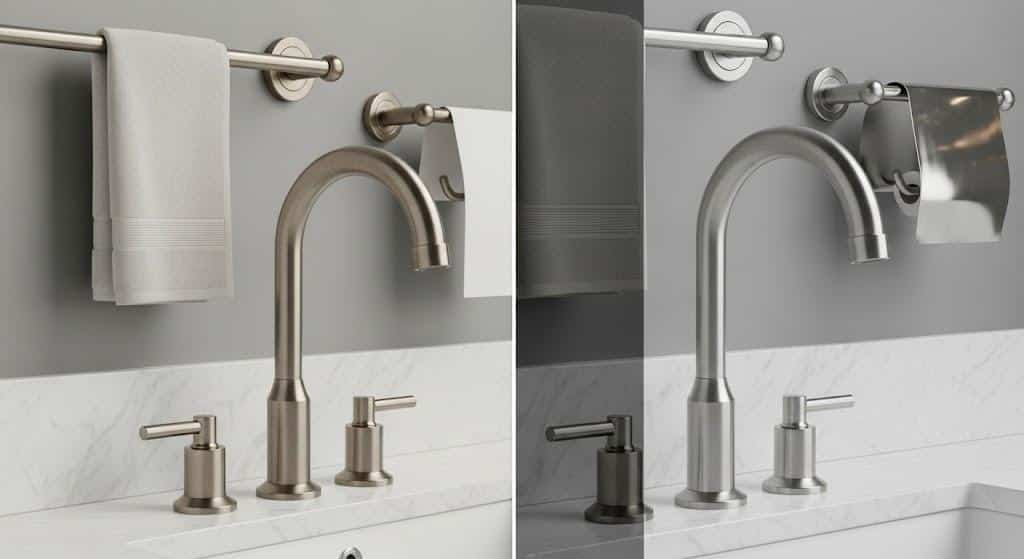
Brushed nickel shines in bathrooms where you want a spa-like, relaxing atmosphere with its warm, golden undertones. This finish complements bathroom vanities, mirror frames, towel bars, and light fixtures while hiding water spots better than stainless steel.
Stainless steel suits modern, minimalist bathrooms where you prefer clean lines and cool tones. However, stainless steel requires more cleaning in bathrooms due to constant moisture and soap residue that shows on the surface.
3. For Open-Plan Homes
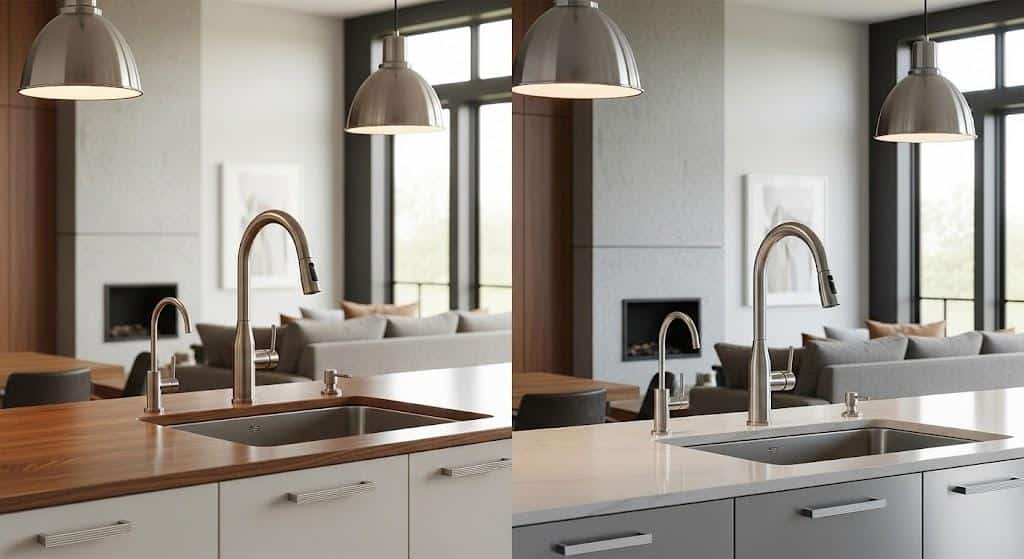
Consistency is key in open floor plans where kitchen and living spaces flow together visually.
Brushed nickel works well when you want to differentiate spaces while maintaining warmth throughout the home. Consider using one primary finish (70%) with the other as an accent (30%) to create visual interest without overwhelming the space.
If your kitchen features stainless steel appliances, carry that finish through adjacent spaces with matching light fixtures and hardware.
Is It Ok to Mix Brushed Nickel and Stainless Steel?
Yes, mixing brushed nickel and stainless steel can work beautifully when done thoughtfully and intentionally.
The key is choosing one finish as your primary metal (about 70% of fixtures) and using the other as an accent (30%) to create visual interest without chaos.
For example, use stainless steel for major kitchen appliances and sink, then add brushed nickel cabinet hardware and lighting for warmth.
Avoid common mistakes like splitting finishes 50/50, mixing more than three metal types in one space, or placing contrasting metals directly next to each other.
Instead, separate different finishes with at least 18 inches of space, stick to either all warm or all cool undertones, and repeat each finish at least twice in the same room for balance.
Comparing Nickel Finishes at a Glance
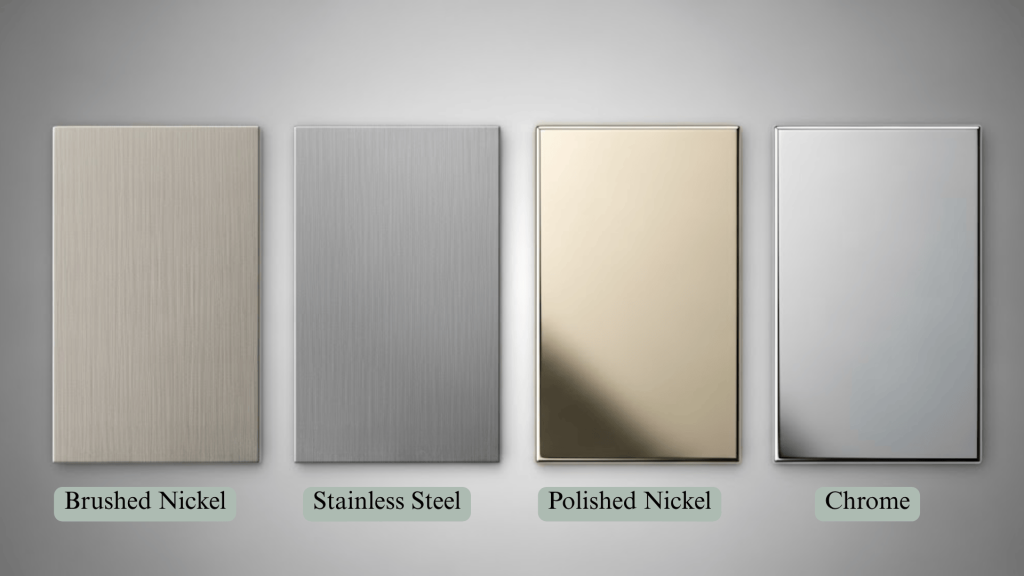
| Finish | Look & Tone | Shine | Maintenance | Best For |
|---|---|---|---|---|
| Brushed Nickel | Warm, muted silver | Matte | Low upkeep | Classic & transitional |
| Stainless Steel | Cool gray-silver | Satin | Easy clean | Modern & industrial |
| Polished Nickel | Warm silver, gold undertone | High | Needs polishing | Luxury & traditional |
| Chrome | Bright, cool silver | Mirror | Frequent wiping | Contemporary |
The Bottom Line
Your choice between brushed nickel and stainless steel comes down to your lifestyle and design goals.
Stainless steel wins for modern kitchens with matching appliances, busy families who need low-maintenance finishes, and homes where durability matters most.
Brushed nickel takes the lead in traditional bathrooms, spaces needing warmth, and areas where hiding water spots is essential.
Pick one primary finish for 70% of your fixtures, then use the other sparingly as an accent. This creates visual interest without overwhelming your space.
Both finishes offer excellent quality and longevity. Your final decision should reflect your style, maintenance preferences, and existing home features.
Ready to make your choice? Browse our collection of brushed nickel and stainless steel fixtures to find the perfect match for your home.
Still unsure? Leave a comment below with your specific situation, we’d love to help you decide!
Frequently Asked Questions
Does Brushed Nickel Match a Stainless Steel Sink?
Yes, brushed nickel faucets can complement stainless steel sinks when you use the 70/30 rule – keep stainless steel as your primary finish and brushed nickel as a warm accent.
What Is the Disadvantage of Brushed Nickel?
Brushed nickel costs more than stainless steel, can show wear in high-moisture areas over time, and may look dated compared to the timeless appeal of stainless steel.
Why Is Brushed Nickel More Expensive?
Brushed nickel requires an extra nickel plating process and specialized brushing techniques during manufacturing, making it 15-25% more costly than standard stainless steel finishes.
What Are the Disadvantages of Brushed Stainless Steel?
Brushed stainless steel is prone to showing fingerprints and water spots, necessitating frequent cleaning with special products, and can appear cold or industrial in traditional design settings.

